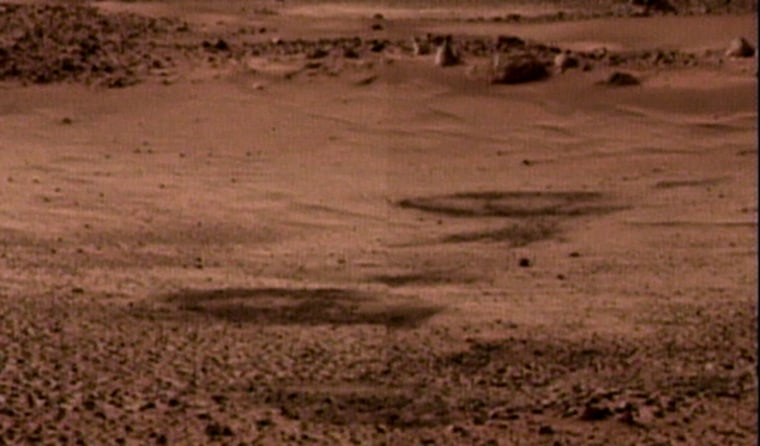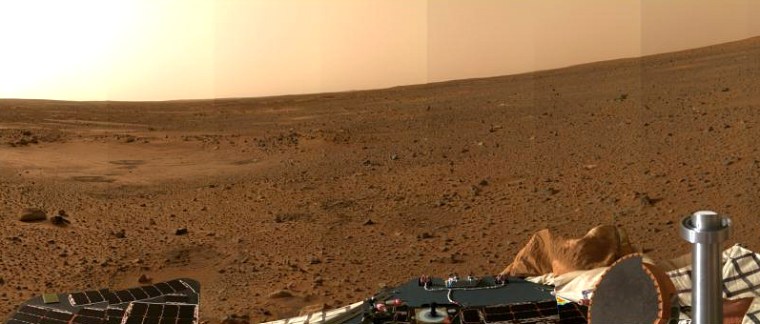Scientists on Thursday released a second stunning color "postcard" from NASA's Spirit rover on Mars, and said the rest of the full 360-degree color view was stored in the rover's memory and waiting to be downloaded.
The northward view shows "Sleepy Hollow," the rock-rimmed depression in the midst of Mars' huge Gusev Crater that is considered one of the prime targets for exploration when the rover rolls off its landing platform sometime next week. Scientists say the depression may be a shallow impact crater, with exposed rock and soil that could open a new "window" into the geological history of the Red Planet.
Two dark doughnut-shaped markings on the soil within Sleepy Hollow may be marks left behind by the rover's airbags, said Cornell astronomer Jim Bell, head of the science team for the rover's panoramic camera. When the airbag-cushioned craft descended to the Martian surface on Saturday, it bounced as high as 26 feet (8 meters), then bumped along for about a half-mile (1 kilometer) like a giant rubber ball rolling to a stop, scientists said Wednesday.

Thus, the view released Thursday may well show where the rover has been as well as where it is going.
The picture appeared to show the Martian terrain rising to the right, but Bell said that was just because the rover had been tilted during the continuing deflation of the airbags. "We're just listing by a few degrees," he told reporters at NASA's Jet Propulsion Laboratory in Pasadena, Calif.
Mission managers say the job of deflating the airbags has been a little more difficult than they were hoping. On Wednesday, they sent commands for the landing platform to lift one of its petals, try drawing in an airbag, then drop the petal again — a "lift and tuck" maneuver. But there was virtually no change in the airbag configuration, mission manager Matt Wallace said Thursday.
"We were not successful in doing that yesterday," Wallace said. He speculated that some of the tendons — cables designed to retract the airbags — may have been snapped during Saturday's landing.
"It's possible that that part [of the airbag] that’s popped up is just not attached to a tendon," he said.
Wallace said the team would continue trying to draw in the airbags, but if the primary path for bringing the rover off its platform remained blocked, Spirit could be commanded to turn one way or the other, then roll off one of the alternate ramps.
The current schedule calls for the rover to move off its platform no earlier than Jan. 14 — which is about three days later than originally planned.
Good news about pictures
Bell said one of the 90-day mission's objectives had already been achieved during the "busiest day yet" for the science team: the capture of the full 360-degree high-resolution color panorama.
About 40 percent of the panorama has now been transmitted back to Earth, via a relay system involving the orbiting Mars Odyssey and Mars Global Surveyor satellites. The rest would be sent over the next two to four days, Bell said.
The high-resolution color imagery will help scientists decide where the rover should go once it rolls off the landing platform. Scientists will also look at data from the rover's Mini-Thermal Emissions Spectrometer, or Mini-TES, which can determine the composition of Martian rocks and soils based on their reflected light.
The rover team has to balance the flow of data between scientific readings and information about the health of the spacecraft — and that means scientists and engineers will have to rely on the satellite relays as well as high-gain, direct-to-Earth communications. One of the engineering team's members, Henry Stone, said the rover's high-gain antenna was "up and running" after earlier glitches.
Deputy project scientist Albert Haldemann said the mission team should be "reaching our stride down the road, maybe a month and a half from now."
Also during Thursday's news conference, student researchers Courtney Dressing of Virginia and Rafael Morozowski of Brazil, both 16, discussed their experiences working alongside Mars scientists as part of an outreach program organized by the nonprofit Planetary Society.
Looking for water and lifeThe Spirit rover bounced to the Martian surface on Saturday after a 300-million-mile, seven-month journey. Over the next three months at least, scientists plan to use the Spirit rover and its onboard cameras and instruments to look for geologic evidence of past water activity in the rocks and soil. If water once filled Gusev Crater, as scientists suspect, it may have been a place suitable for life.
Spirit's twin, Opportunity, is due to touch down in another region of Mars, Meridiani Planum, on Jan. 24. It will study the region's hematite deposits, looking for further clues as to ancient Mars' geology. The key question for the $820 million, "two-for-one" missions is whether water persisted on the planet long enough to allow the potential development of life.
The Mars Exploration Rover mission is part of a scientific campaign that will stretch for more than a decade, aimed at seeking traces of life on Mars. Water is a key element of that search, since on Earth, life is found virtually everywhere there is liquid water. Past missions have led scientists to believe that, billions of years ago, Mars was much warmer and wetter than it is today.
